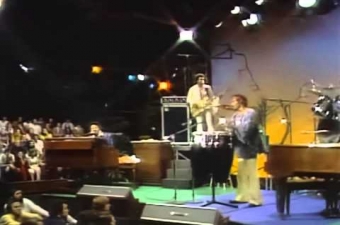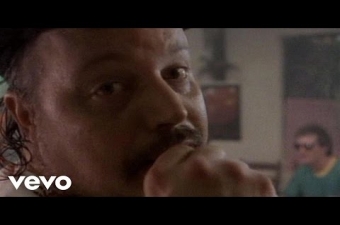Ivanhoe
601 Bourbon StreetNew Orleans LA 70130
Some of New Orleans’ top artists played the Ivanhoe in the 1960s, from R&B stalwarts Clarence “Frogman” Henry and Frankie Ford to “Willie Tee” Turbinton’s modern jazz outfit. It was also a place where musicians could gather, experiment, and fine-tune their sound.
This scene helped give rise to the Meters, among the most influential New Orleans bands of the era. After a successful run of shows with his brothers at the Nite Cap, Art Neville took a regular gig here around 1968, bringing three masterful players with him: Joseph “Zigaboo” Modeliste on drums, George Porter, Jr. on bass, and Leo Nocentelli on guitar. “Really, playing the gig at the Ivanhoe was the thing that got us tight,” recalled Porter, “‘cause we were playing six nights a week.“ No rhythm section has ever been tighter.
They caught the ear of Allen Toussaint, who made them a house band at Jazz City studio where they recorded backing tracks for Lee Dorsey, Betty Harris, and others. Dubbed the Meters in 1969, they scored hits of their own with “Cissy Strut” and “Sophisticated Cissy,” instrumentals built on their material from the Ivanhoe. They toured the world in the 1970s as critical darlings, with a string of irresistibly danceable albums paced by Modeliste’s second line-inflected drumming.
The group continued recording with Toussaint, too, playing on classics such as Labelle’s “Lady Marmalade” and Dr. John’s “Right Place, Wrong Time.” Besides being hometown heroes, they proved to be pioneers of the funk genre, and, later, favorites of DJs looking for samples.
They weren’t the only well-known band to trace its origins to the Ivanhoe. A jam session here in 1971 brought together for the first time keyboardist Ed Volker, drummer Frank Bua, and guitarist Camile Baudoin. They formed the Radiators in 1978, adding guitarist Dave Malone and bassist Reggie Scanlan, with Volker as the primary songwriter.
In the ensuing decades the Radiators built a devoted following based largely on their live performances in venues such as Tipitina’s and M.O.M.’s Ball, the notorious Carnival bacchanalia. Fans dubbed themselves Fish-heads, evoking the followers of the Greatful Dead. The 1984 “Fish Head Manifesto” preached:
Party Down Now! Back to the marshes ! Back to the bayous ! the rivers, lakes,
lagoons ! Back again to our salty father’s aquatic beginnings. Fall in love with
mermaids, dance with octopi. Cast off your big brown shoes, get squishy, and
wiggle for all you’re worth.
They played to eager fans around the country before hanging up their rock and roll shoes in 2011. They still reunite for special occasions.
Today, this creole cottage is home to a bar called the Old Opera House that presents cover bands. It’s the same name used by the rowdy strip club that operated here in the 1950s and early 60s before the Ivanhoe moved in, which referred cheekily to the French Opera House that once stood across the street.
About Bourbon Street
Bourbon Street, one of the most famous streets in the country, is only 14 blocks long, running through the middle of the French Quarter. It took off as an entertainment district in the 1940s, when wartime activity brought waves of visitors to New Orleans. Bands often performed in floor shows featuring burlesque dancers (who stripped to varying degrees), comedians, and other entertainers.
This freewheeling era came to a close, in the eyes of many patrons, with District Attorney Jim Garrison’s vice raids in the early 1960s. Crime — organized and not — was pervasive on Bourbon Street, and Garrison’s crusade scored some political points. The resulting loss of revenue at the clubs, meanwhile, scaled back entertainment budgets.
The only black people on Bourbon Street at the time were there to work (musicians were generally considered hired help; some had to wait in storerooms between sets). Even after the passage of civil rights legislation some clubs resisted integration, and audiences on Bourbon Street remained largely white for years afterward.
In recent decades, as the city relied increasingly on tourism to prop up its economy, the market dictated more changes: Modern stripping supplanted burlesque and DJ booths replaced bandstands. The street became a pedestrian mall, filled with go-cups and Mardi Gras beads year-round. Several clubs sticking with live music offered low wages for bands to play songs familiar to visitors.
Hand-wringing about the quality and nature of live music on the strip has been more or less constant since the 1950s, and not without reason. Still, some venues persisted in hiring reputable artists. In the 2000s, the To Be Continued Brass Band took matters into their own hands, breaking into the scene by playing on the corner of Bourbon and Canal Street every night.
In any case millions of visitors to the strip each year find the spectacle they’re looking for, exotic but approachable, with a more permissive atmosphere than they feel at home. Its economic impact on the city is in the billions. If it’s crass it’s also egalitarian: Bourbon Street today is among the more integrated spaces in town.
Videos

From the 2017 Ponderosa Stomp Music History Conference, Meters bassist George Porter, Jr. and drummer "Wacko" Wade Wright discuss gigging on Bourbon Street in the 1960s (Porter talks about the Ivanhoe at 8:00).
Video posted by The Ponderosa Stomp Foundation.
From the 2017 Ponderosa Stomp Music History Conference, Meters bassist George Porter, Jr. and drummer "Wacko" Wade Wright discuss gigging on Bourbon Street in the 1960s (Porter talks about the Ivanhoe at 8:00).

From 1974, The Meters perform "Look-Ka Py Py" and "Jungle Man," introduced by Dr. John.
Video posted by FunkensteinJr.
From 1974, The Meters perform "Look-Ka Py Py" and "Jungle Man," introduced by Dr. John.

From 1987, The Radiators' music video for "Suck The Head" serves up boiled crawfish with extra corn.
Video posted by TheRadiatorsVEVO.
From 1987, The Radiators' music video for "Suck The Head" serves up boiled crawfish with extra corn.
Images



















